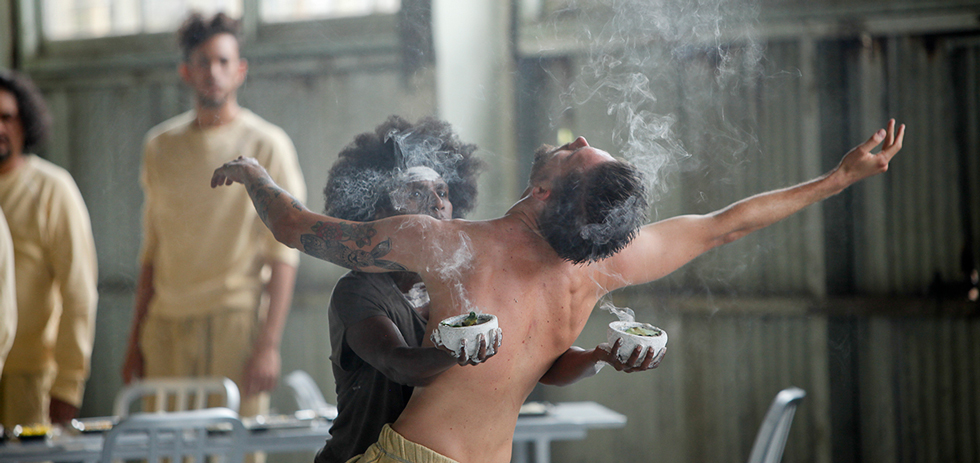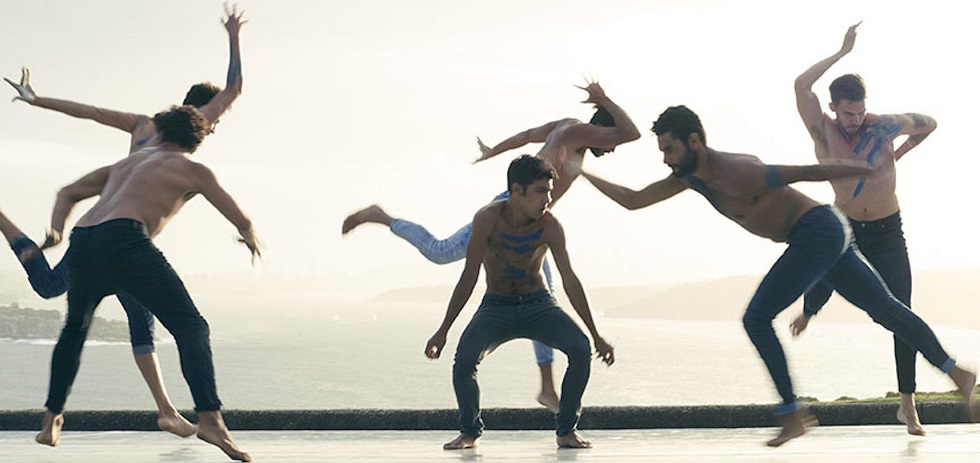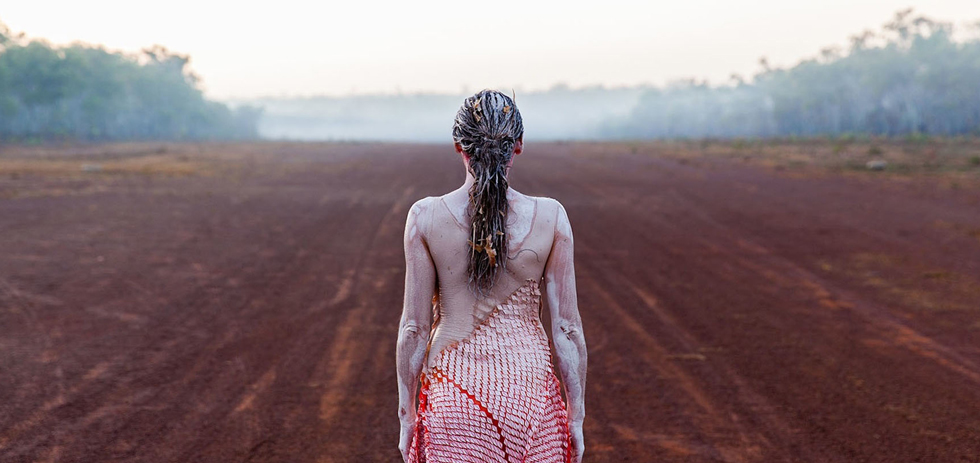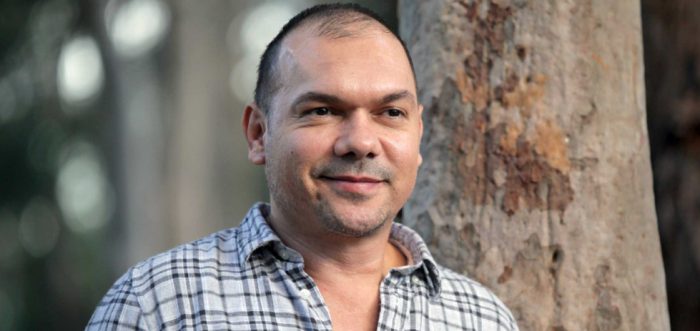The artistic director of the Bangarra Dance Theatre, Stephen Page, has brought the striking dance performance Spear to the big screen. Having had its world premiere in Toronto last September, the film opens in limited release across Australia from the 10th of March. You can read our rave review of the film by Eloise Grills here.
I’d love to start by asking how the process of adapting a theatre piece into a film came about for you?
The Adelaide International Film Festival has a program called The Hive Initiative, and that initiative is – I think they give it out every year, or every second year, and this was the second round of it. They choose two first time directors, with first features. And really it’s about performing arts companies working with filmmakers and film producers. And so Robert Connolly, Arena Media and John Harvey from Brown Cab Productions, who also work under Arena Media, produced the ten-minute short I did for The Turning, “Sand”. I think that was like 2012? 2013? He got 17 actors, theatre directors and film directors to do ten minutes each out of the 17, and I was one of those. Robert loved what I did for The Turning and he was seeing a live Bangarra show with me at the end of 2013 and he said, “You know they’ve got this Hive project?” and I said “Really?”. He said, “Do you want to make your first feature? Maybe you can take an idea from your dance works that you’ve done.”
And the only one I thought of that could translate was Spear, but it was only a 38-minute dance theatre piece, based on men’s business, contemporary black men’s business basically, and how we respond to that in the 21st century. So I think I threw a wide camera shot of the 2000 theatre piece at the Drama Theatre on a USB and then poor Rob wrote a one page synopsis and we sent it off. I didn’t hear from him for like three months, so I think it would have been February 2014, and he rang and said, “Do you want the good news, or the bad news?” I said, “What’s going on?” And he said, “You got chosen to do your first feature! But the bad news is, it has to premiere at the Adelaide International Film Festival in October 2015.”
So literally I had a one-year process. And the thing with Bangarra is that we’re triennially funded as a Major Performing Arts Company with the Australia Council, so we already had our program sorted out. So I had to figure out how we were going to shoot around that program, as well as do everything else. It did ruffle a few feathers – but in a good way. And then I had to seduce my board, saying, “OK, we’re moving into a different medium.” It meant moving a lot of things around, but I was so glad we did it, because I realised I’ve been at the company for 25 years this year, I’ve created 30 dance works, we’ve travelled the world, travelled the country, travelled into rural communities. We still have our existing relationships with indigenous communities which we’ve had right from the start. I just got back yesterday from Arnhem Land, running workshops with the dancers up there and showing Spear on a blow-up screen – there were three actors that came down from the area that played the traditional aspects in the film.
Why am I saying all that? It was like it was meant to be, to take the story and work in the medium of film. To get that opportunity was great.
So this is something I’m really fascinated by. Robert Connolly’s approach with The Turning was about liberating film from its conventions, and this idea that you have to bring in new people from different art forms to do that. This seems to be something that you’re now continuing to do – I remember in the first couple of scenes of Spear I thought, “This really is something completely different.” It’s so invigorating as a result – to see something that doesn’t play to the conventions that audiences have seen so much.
Where did you see it?

I saw it at the Sydney Festival screening.
Oh you’ve probably already heard me raving on. It was really great to screen it in the Drama Theatre actually, because that’s where we perform. I thought that was one of the best screenings we had. Maybe that was because I went there the week before to make sure it was completely dark and the music was turned all the way up. I think because it doesn’t have much dialogue, it was really interesting to see it play in that space. I’ll be interested to see how it plays here at opening night in Melbourne, if it still has that black cave vibe to it.
I was really drawn to the way the worlds of the film are constantly colliding – the traditional and the contemporary for the characters, but also this idea that as a filmmaker you’re straddling two worlds, with choreography as your background. Then this is expanded into David Page’s music. Is that something that you worked with Bonnie Elliott to develop?
Bonnie did “Sand” with me on The Turning. When Rob and the team approached me for Spear, the first thing Rob asked was “Will you work with Bonnie?”. The funny thing is when Bonnie and I worked together on “Sand”, and I told her I didn’t want any dialogue and that I wanted to create this physicality in the drama of the actors we chose, she loved that. And it’s probably a cinematographer’s dream, because the less dialogue you have – I just saw The Revenant, in the first fifteen minutes there’s very little dialogue but there’s that scope to the cinematography. So for Bonnie to go, “Are you serious? Are you going to do a film that’s probably going to have 5% dialogue?” She loved it. And then somehow taking it from the theatre and finding these different worlds, and external and internal atmospheres where the photography plays out.
We sort of got married early on and when I told her I only had a year she was great, I think she dropped a lot of things. It’s a different world to theatre scheduling and so forth, it’s a lot more gruelling – we did a three-week shoot, five days each week, late finishes, by 6pm you have to drop everything and that’s it. So we would wake up early in the morning, she would pick me up and we could talk on the way to the set. We would get together with my crayons and map out the pictures. I felt like I was back at university, doing story boards. But we really prioritised, because we were up against time, and obviously there was no money, so I think we were wonderfully ambitious as well. I think she probably liked that streak in me, “Are you really going to go for what you want?”. And I thought, “Well yeah, let’s just do it”. I had really good people working on it, and I deliberately brought my creative team from theatre, and the choices of David’s music. And then Simon Njoo the editor – he was amazing as well. He had just come off The Babadook and I couldn’t find an editor until the very last minute. I think because they were reading 48 pages, which was like a scriptment and I think they weren’t getting it. It had no dialogue, they really were struggling. And I thought, “Oh my lord, what am I going to do?” Bonnie had met Simon through someone else and I sent him the treatment in the morning, he emailed me in the afternoon, we met the next morning and he was on by lunchtime the next day. But he did a lot of that from when he worked in Paris in France, so he just loved it. I think for an editor and a DOP, it’s a dream job. They’re just working with music and photography. Even though there are dancers.

It’s interesting to come back to this idea of bringing Spear back at this time – in the original dance piece you dealt a lot with contemporary issues for Indigenous men and it’s still incredibly relevant. Years later, it hasn’t lost any of its potency because they’re still critical issues. Did you feel coming back to it that nothing had changed or that we were dealing with different problems?
I was having a big talk about that – are the Indigenous issues getting better, are they changing? I just think we’re such an evolving race, we’re so diverse and complex. And I often tend to think, when we’re talking about these systems and how we’re evolving, “Are we the underdog?” And I tend to be a bit more optimistic – we’re on a different road. I love those big red signs on highway, “Wrong Way Go Back”. I feel like I’m the person that would just keep going through that sign. I’ve been doing that for the last 30 years. I remember when they did the Sorry walk in 2000 for reconciliation, and my son was about 7. We were walking over and he asked, “Dad, why is everyone so happy? White, Chinese, Aboriginal?” He is so worldly. And I said, “Because everyone is coming together.” And he said, “Yeah, but dad, at my school I sit with Chinese kids, Aboriginal kids, Iranian kids. We’re always laughing every day.” And I said, “Yeah, but you’re the next generation.”
So why I say it like that, is that I always feel like I’ve been around great optimistic leaders, even if they’re visual artists, filmmakers, or my black peers that have been black activists but at the same time they’re wanting this sense of hope. I think a lot of my black peers that work in their lifetime professionally are caretakers, are asserting the social strata of their cultural issues – I think that’s just great. I’m not saying, “If we weren’t colonised in the wrong way, what sort of country would we be?” But imagine a film about that, what if, what if there weren’t these hidden holocausts and massacres. I often think – the visual storytelling is so rich, it painted a different future of who we are. Maybe we wouldn’t be called Australia, maybe we would have been called some great name that a thousand different clans all came together and came up with. I have this romanticism about what we would have been. And still you can’t escape evolution and yet you also still can’t escape those explorations that we come up against. But I tend to feel we really still are a young country in its identity and in the issues we face.
The character that Aaron Pederson plays, the Suicide Man, who has this poetic role in the film, I felt that he operated as a potential future for Hunter Page-Lochard’s character Djali. If he’s caught between these two worlds, this is where one of those roads leads?
Yeah I think he’s also a physical symbolism. The liberty of no dialogue for cinematography is just bodies being. The landscape, an internal bowling alley, an ochre red or white paint, of any of those things in the film, I thought that he had the hardest role because he had to play the actor, he had to be the closest to the Western challenges. Someone that has left a footprint or created a footprint in that Western system. And yeah, that’s right, he was an opposing challenge for the lead character along the way. I suppose the lead character, Hunter’s character, his spirit really filtered through everybody’s chapters, everybody’s stories. And I think by the end he was saying, as long as I am open to the spirit and the optimism of that, he might never find the balance between those two worlds, but I think he will accept that that is the challenge his fate and spirit has.

There’s also this quite beautiful comedy to the film, with those moments on the escalator and in the bowling alley. Was that important to you, to keep a light touch in places?
I think when we were putting together those 48 pages, and we got to 24, and everything was so dark and boring and I just said, “Oh god, I would not want to watch this film. It’s so depressing, who would want to watch this film?” So I sat down with Justin Monjo, the screenwriter, and said, “It would be good to give these little cultural additions that are quite warm. I’ll go and get an elder and the elder comes from a different world to the Western system and the boy has grown up with the knowings of that, and let them have this conversation and see how they respond together.” And some of it is silly and a little bit pretentious, but to bring a bit of warmth – I had a black peer say to me, if you’re going to deal with social issues you have to hit them hard, and they thought I overstylised it. And that’s fine, I think, sure, I could have done the Samson and Delilah and had the alcoholic character hit by a car and created that, had a stunt double and done all that. But that wasn’t the intention. I really wanted to find an honesty to the stylisation that we set out to do in the beginning.
I was wondering how much Aaron’s character’s arc was tied into your own experience with your brother Russell and his suicide.
Totally. And you know what – Wayne Blair was going to play the role, he played the original role in the theatre piece but Wayne pulled out at the last minute because he’s become Mr Hollywood. So I went to Aaron and he read the treatment and rang me back immediately and he said “Bro, if this was like 10 years ago I don’t think I could do it.” But because he’s dealt with black men’s suicide in his life, and I have, he thought it was important to show it. And he loved the stylised way I was doing it – bleak, dark, he thought it really hit a sense of accepting the spirit of these issues. He just said, “Yep, let’s do it.” I only brought him up for three days to do his stuff, and that whole suicide scene that was just one take, just a couple of cameras. He and I just sat for five minutes and talked about it – we just really wanted to pay respect to the spirit of it, even if you are dealing with death. It was harder for Hunter, I think, than both of us. Because if it were him and he came into that scene, he would probably run and try to get him off the chair, so it was hard for Hunter to work out how he had to respond in that quiet way.
And that was an experience difference? That you get to that point in your life where you understand that quietude?
Yeah I think so. I think a lot of it – one journalist said to me, it’s really about you and your life and what you’ve been through. And I’m sure a lot of it is – my theatre work has always been based on what I deal with in my own backyard, my political climate at the time, and my issues are often those of my black peers and my community as well. That’s what helps the spirit of it, that it has come from occurring, realistic events.
And an authenticity?
Yeah I hope so. I hope people just accept its stylisation and just surrender to it. It’s not a traditional film.
Spear is out in limited release from 10 March.
